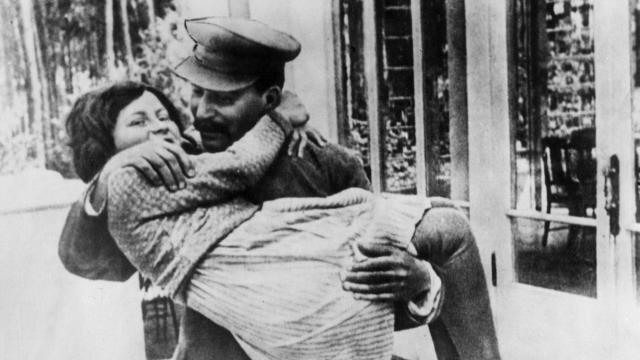Imagine being a weary commuter on your way home from a long day of toil. You descend into the subway and wait for a train. One arrives, you slowly board and ease yourself down into a seat, finally able to rest for a moment.
Then, a few stops later, the leader of your country, Josef Stalin, boards the train and stands next to you.
This may sound like the set-up of a bad stand up joke, but it happened.
This anecdote and all the accompanying details are from Princeton historian Stephen Kotkin’s excellent biography, Stalin: Waiting for Hitler, 1929-1941. In a book of surreal, perplexing, and often bizarre moments, this one still stands out to me as one of the most absurd.
On the evening of April 22, 1935, Stalin was having dinner with his family. They were celebrating the birthday of his daughter’s governess, Maria Svandize. As they were offering toasts, Stalin’s daughter, Svetlana, spontaneously remarked she wanted to take a ride on Moscow’s brand new, very beautiful Metro system that had just opened.
Kotkin describes Stalin as being “in a good mood” that night, which seems key to what happened next. As Kotkin wrote, “Suddenly, Stalin said he wanted to go, too.” He called up his buddy and Soviet Chairman Vyacheslav Molotov to tag along.
“Everybody was terribly concerned,” Svanidze wrote her diary, “There was a lot of whispering about the danger of such an outing without proper preparation.” Lazar Kaganovich, another inner circle member and transport commissioner who was also present, wasn’t in love with the idea either. Kotkin described him as “pale” at the prospect of three of the country’s most powerful men spontaneously going into public, much less a closed, confined space. He tried to get the Stalin family to take their ride after midnight when the system had shut down. But, Stalin was having none of it.
Here’s what Kotkin wrote about the rest of the outing:
They drove in three cars to Moscow’s Crimea Square and descended into the station, waiting for what turned out to be twenty minutes; a train arrived already packed. Workers decoupled the car with the motor and Stalin’s group was off, to Hunters’ Row, the station closest to the Kremlin, where he inspected the station and the escalator; onlookers erupted. Stalin ended up surrounded by well-wishers. Bodyguards and police had arrived and tried to bring order. The crowd smashed an enormous metal lamp. Svanidze was nearly smothered against a column. Vasily [Stalin’s son] was scared was scared for his life. Svetlana was so frightened, she stayed in the train car. We ‘were intimidated by the uninhibited ecstasy of the crowd,’ Svanidze wrote. ‘Iosif [Stalin] was merry.’
This was an unstaged moment catalyzed by his daughter. Stalin reboarded, travelling to the end of the line, Sokolniki, where he was supposed to get into a waiting automobile, but he decided to stay on board and return to Smolensk Square, where no vehicles were waiting (the train beat them). He and his entourage went on foot toward the Arbat as rain descended and puddles formed. A car finally arrived. Svetlana and Vasily were taken to the Kremlin apartment, where Vasily ‘threw himself on the bed and cried hysterically.’ Stalin headed to the Near Dacha [his villa on the outskirts of Moscow]. Evidently, his obsession with possible assassination was in abeyance that evening: regular passengers had been allowed to ride in the train carriage with him from Hunter’s Row. ‘Iosif smiled affectionately the whole time,’ Svanidze wrote in her diary. ‘I think that, despite all his sobriety, he was touched by the people’s love and attention to their Supreme Leader…He once said about the ovations offered to him that people need a tsar, that is, someone to revere and in whose name to live and labour.’”
I first came across this passage about six months ago and it has stayed in my mind ever since. It’s difficult to convey, without reading Kotkin’s 909-page work (Volume 2 of 3, by the way), the total absurdity of this event. At this point, most Russians had never seen Stalin, except for in portraits, which were the photoshopped magazine covers of the day. His public appearances were similarly controlled as staged propaganda exercises. Stalin was regarded as something like a secular god, even though he had manufactured a famine that starved millions of his people by exporting vast quantities of grain in exchange for industrial machines to modernise the economy and military. Of course, the people didn’t know that. They were only told how Stalin and his brilliance was what kept the survivors alive.
Plus, Kotkin’s call to Stalin’s “obsession with possible assassination” makes the impromptu subway trip even more bizarre. This was a man who suspected damn near every one of plotting to kill him, even (especially?) when they weren’t. He had countless people tortured and murdered because, in Stalin’s mind, they were backstabbing traitors plotting his demise when in fact their loyalty had remained untarnished.
For this guy to wade into throngs of people without the slightest concern, with a smile on his face, without any meaningful security boggles the mind. It is one of the most anomalous anecdotes in Kotkin’s entire work. Apparently, even Stalin couldn’t resist a brand new subway.
